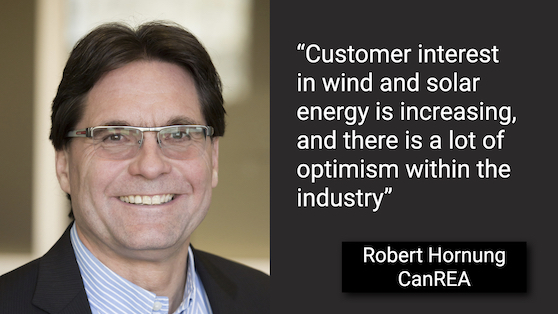
Articles
Features
Articles
CanREA reports 2020 provided a “solid foundation for growth” in 2021
January 28, 2021 | By Anthony Capkun
 Photo courtesy Canadian Renewable Energy Association.
Photo courtesy Canadian Renewable Energy Association. January 28, 2021 – The Canadian Renewable Energy Association (CanREA) reports that Canada’s wind energy, solar energy and energy storage sectors “ended 2020 in a strong position, ready to expand significantly in 2021”.
“Despite considerable challenges posed by the global pandemic, Canada ended 2020 with a total wind capacity of 13,588 MW, a total solar capacity of approximately 3000 MW, significant growth in energy storage, and a positive forecast for 2021,” said Robert Hornung, president & CEO.
“In addition, growing corporate demand, coupled with policy commitments made by governments at all levels in 2020, promise strong and accelerating growth for our technologies in 2021 and beyond.”
While the pandemic caused supply-chain disruptions, energy-demand fluctuations and workforce health concerns—all of which temporarily delayed many renewable energy projects from coming online in 2020—Canada continued to see activity in both large-scale solar and wind-energy construction.
At least 70 MW of solar PV capacity was installed in 2020, along with an additional 166 MW of windpower. Wind and solar generation now meet 40% of electricity demand in Prince Edward Island and 18% in Nova Scotia, CanREA added.
With 240 MW of large-scale solar projects and 745 MW of wind projects already under construction across Canada, CanREA says “we anticipate significant expansion over the next year”. Overall, “we expect close to two gigawatts of wind and solar projects to be installed or to begin construction in 2021”.
The field of energy storage is also growing rapidly, CanREA adds: Canada currently has a total utility-scale energy storage capacity of more than 130 MW/ 250 MWh, 10% of which came online in 2020 alone.
With continued cost decreases, and emerging regulatory and market frameworks that will enable more energy storage deployment, both utility-scale and smaller-scale (residential and commercial) energy-storage options are likely to see continued expansion in 2021, CanREA foresees.
Despite its challenges, 2020 also promised significant new opportunities from all three levels of government. The Province of Saskatchewan and the City of Edmonton launched procurement processes, with Saskatchewan also seeking feedback on interest in battery storage projects in the province. Meantime, the federal government and the Province of Quebec each announced their intention to procure low-cost, non-emitting electricity in future.
The year ended on a positive note, says CanREA, with Ottawa announcing a new climate plan in December, and Quebec presenting its new electrification strategy in November. Wind, solar and storage are expected to play a central role in both to meet commitments for the reduction of greenhouse gas emissions.
Throughout 2020, renewable energy also continued to deliver for companies looking to reduce their carbon footprints, says CanREA. Some examples include RBC signing a contract to procure green energy directly from BluEarth Renewables and Bullfrog Power, and Capital Power announcing new wind and solar projects intended to reduce their own overall emissions.
“Customer interest in wind and solar energy is increasing, and there is a lot of optimism within the industry,” Hornung added. “We are ready to deliver the renewable energy solutions that will be central to Canada’s energy transition, with benefits for all Canadians.”
— With files from Canadian Renewable Energy Association.
Print this page